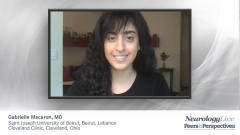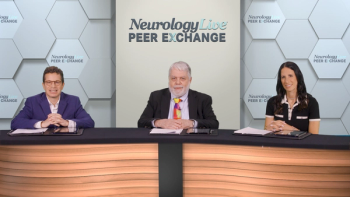
Novel Oral Treatment Selection in RRMS
Following previous discussions about novel oral therapies available as treatment for relapsing-remitting multiple sclerosis, a small panel of neurologists comment on factors that affect which agent they select.
Episodes in this series

Jennifer Graves, MD, PhD, MAS: Looking at these lists for different classes of medications and trying to help colleagues who may practice in other things in addition to MS [multiple sclerosis] can be a bit dizzying, particularly among the S1P [sphingosine-1-phosphate] choices. With 4 different drugs, it can be difficult to make a decision. We’ve talked a little about the difference with siponimod [Mayzent], the different population, and the questions about active secondary progressive MS. But between the fingolimod [Gilenya] trials and the ozanimod [Zeposia] SUNBEAM and RADIANCE trials, were there any differences that either of you noticed that would help a clinician decide between fingolimod or ozanimod for any individual patient?
Gabrielle Macaron, MD: One of the differences in the results is that with ozanimod, there wasn’t a significant difference in the proportion of patients with confirmed disability progression while comparing ozanimod with interferon, whereas this effect was seen with other S1P modulators. I don’t know what to make of this result, but maybe ozanimod is less effective than other S1P inhibitors. It’s too early to tell. And as long as we don’t have head-to-head studies, we can’t really say.
Suma Shah, MD: The other 1 that we haven’t mentioned yet is ponesimod [Ponvory]. The 1 thing that stood out to me in the trials was a chart at 108 weeks showing an improvement in fatigue scores. These are patient-reported outcomes. That’s 1 thing that we’re starting to get better at in the MS world. That was impressive to me to show at 2 years out from therapy that patients have improved fatigue. If that’s a primary symptom, it may be worth considering for patients.
Gabrielle Macaron, MD: It’s really interesting. It’s the first time that fatigue was used as a prespecified end point. In real life, it’s the symptom that we hear the most.
Suma Shah, MD: Yes.
Jennifer Graves, MD, PhD, MAS: Those are all great points. I’ll reflect a little before we move on. In thinking about these different medications, I made the point that different medications have onset at different timeframes. The fumarates take a little longer than the S1P receptor modulators to have full protection, and that may or may not be relevant for an individual patient. If you have someone in front of you who’s already relapsed 2 times this year, you may be interested in something that works quicker. For the S1P receptor drugs, we typically say that within about a month there should be enough drug built up in the system for the full efficacy shown in the clinical trials. For the fumarates, there might be some differences, but it’s in that category of somewhere around 3 months or maybe up to 6 months for full efficacy of the medication. But you may have a patient in front of you who has a history of skin cancer or a personal history of lymphoma and has only had 1 relapse in the last 2 years. That might actually be the best medication for that individual.
You guys outlined really well the possibilities and benefits of considering cladribine [Mavenclad] for some patients. Pregnancy isn’t possible on any of these drugs. We have to keep in mind some potential for rebound off of some of our drugs that someone stops for pregnancy and make sure we plan for that. Do you have any other reflections when you look at all these drugs to look for factors that you would use to pick one for a patient or help make a shared decision with a patient about an oral drug?
Suma Shah, MD: This will reflect back a little to my own practice, but what we know about MS is there are certain things that can confer a poor prognosis. If I see those types of things as we’re looking within the orals, I may choose certain ones. For example, we know that spinal cord involvement, repeated recurrences, or a high level of disability at the time of diagnosis may portend a poor prognosis. In those patients, if they’re choosing among oral therapies, I may choose between cladribine or the S1P inhibitors because it seems on the whole that their annualized relapse reduction rate and overall ability to provide sustained response to treatment is a little higher. However, for some of my patients who have standard, first-time optic neuritis with a couple of brain lesions that are mild and don’t have any clinical symptoms, dimethyl fumarate or a fumaric acid ester or teriflunomide [Aubagio] may be a completely acceptable option to allow them the ease of oral therapy and give them protection on the whole.
Jennifer Graves, MD, PhD, MAS: I’ll reiterate that it’s very important to take into consideration that the most important thing is to pick a medicine the patient will take and be able to adhere to. Some of these drugs require more monitoring and different types of monitoring. Some individuals have different individual level risk factors. We don’t often remember to mention this, but fumarates require normal kidney function and creatinine levels. Every once in a while, that comes up as an issue with patients. Similarly, with S1P, if someone has a personal history of skin cancer or a very strong family history of melanoma, given that there’s a rare risk of that with that class of medications, that might guide our treatment decision.
Social factors are also important. As we mentioned, 1 advantage with ozanimod over fingolimod with overall very similar efficacy data is that they can titrate it at home. There are some people who struggle with childcare and time away from work. Even though that one 6-hour period seems like such a small thing for some of us to consider, that can be helpful, and we take that into account as well. But some patients also have other factors, so it’s important to keep all of that in mind.
Thank you for watching this NeurologyLive® Peer Exchange. If you enjoyed the content, please subscribe to our e-newsletters to receive upcoming Peer Exchanges and other great content right in your inbox.
Transcript edited for clarity.
Newsletter
Keep your finger on the pulse of neurology—subscribe to NeurologyLive for expert interviews, new data, and breakthrough treatment updates.



























